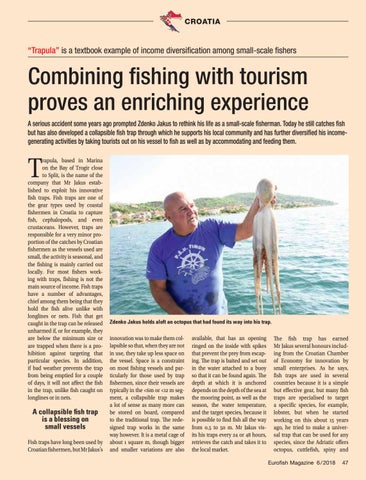CROATIA
“Trapulaâ€? is a textbook example of income diversiďŹ cation among small-scale ďŹ shers
Combining ďŹ shing with tourism proves an enriching experience A serious accident some years ago prompted Zdenko Jakus to rethink his life as a small-scale ďŹ sherman. Today he still catches ďŹ sh but has also developed a collapsible ďŹ sh trap through which he supports his local community and has further diversiďŹ ed his incomegenerating activities by taking tourists out on his vessel to ďŹ sh as well as by accommodating and feeding them.
T
rapula, based in Marina on the Bay of Trogir close to Split, is the name of the company that Mr Jakus established to exploit his innovative fish traps. Fish traps are one of the gear types used by coastal fishermen in Croatia to capture fish, cephalopods, and even crustaceans. However, traps are responsible for a very minor proportion of the catches by Croatian fishermen as the vessels used are small, the activity is seasonal, and the fishing is mainly carried out locally. For most fishers working with traps, fishing is not the main source of income. Fish traps have a number of advantages, chief among them being that they hold the fish alive unlike with longlines or nets. Fish that get caught in the trap can be released unharmed if, or for example, they are below the minimum size or are trapped when there is a prohibition against targeting that particular species. In addition, if bad weather prevents the trap from being emptied for a couple of days, it will not affect the fish in the trap, unlike fish caught on longlines or in nets.
A collapsible ďŹ sh trap is a blessing on small vessels Fish traps have long been used by Croatian fishermen, but Mr Jakus’s
Zdenko Jakus holds aloft an octopus that had found its way into his trap.
innovation was to make them collapsible so that, when they are not in use, they take up less space on the vessel. Space is a constraint on most fishing vessels and particularly for those used by trap fishermen, since their vessels are typically in the <6m or <12 m segment, a collapsible trap makes a lot of sense as many more can be stored on board, compared to the traditional trap. The redesigned trap works in the same way however. It is a metal cage of about 1 square m, though bigger and smaller variations are also
available, that has an opening ringed on the inside with spikes that prevent the prey from escaping. The trap is baited and set out in the water attached to a buoy so that it can be found again. The depth at which it is anchored depends on the depth of the sea at the mooring point, as well as the season, the water temperature, and the target species, because it is possible to find fish all the way from 0.5 to 50 m. Mr Jakus visits his traps every 24 or 48 hours, retrieves the catch and takes it to the local market.
The fish trap has earned Mr Jakus several honours including from the Croatian Chamber of Economy for innovation by small enterprises. As he says, fish traps are used in several countries because it is a simple but effective gear, but many fish traps are specialised to target a specific species, for example, lobster, but when he started working on this about 15 years ago, he tried to make a universal trap that can be used for any species, since the Adriatic offers octopus, cuttlefish, spiny and Eurofish Magazine 6 / 2018
$ ! )+&&
47
